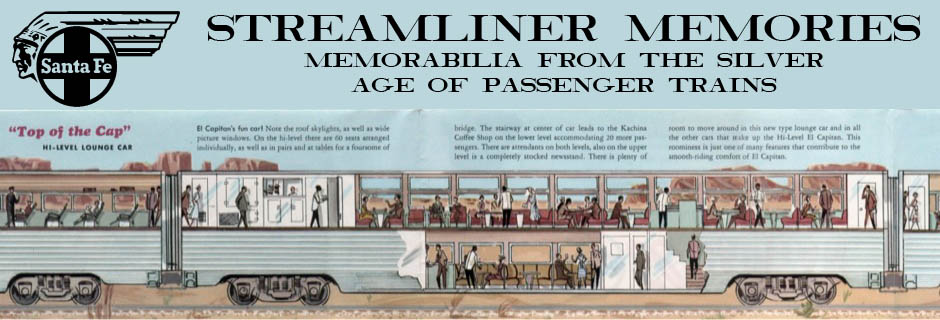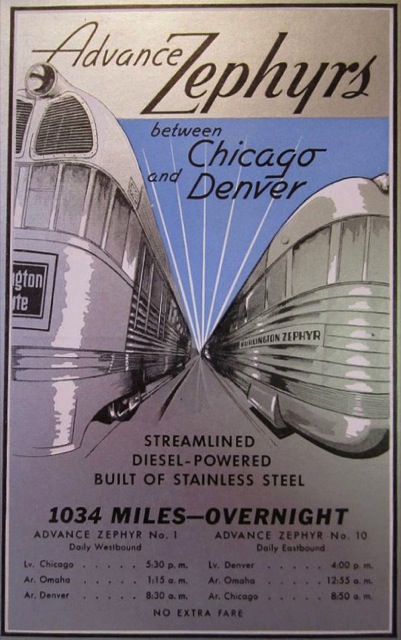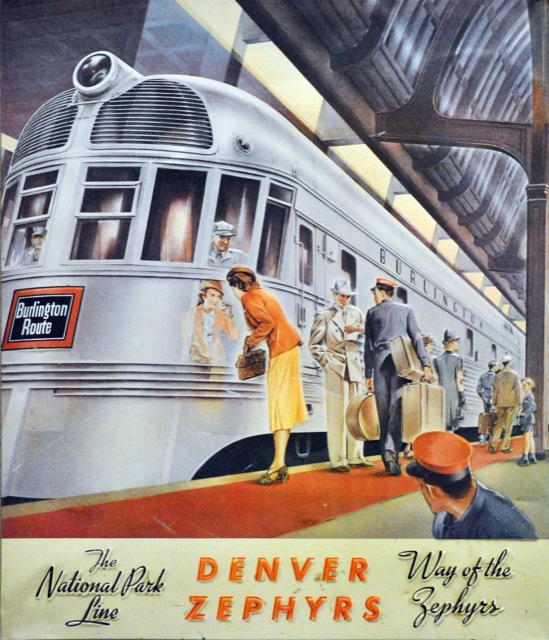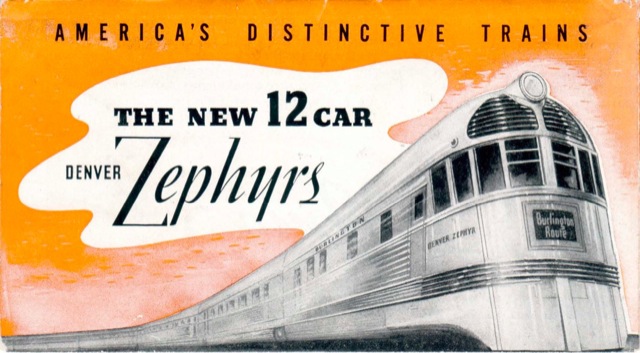When, in June 1936, the Union Pacific put the M-10005 and M-10006 in daily service between Chicago and Denver, the Burlington’s own sleeping-car equipped Denver Zephyr was still five months away. To steal the Union Pacific’s thunder (and protect its mail contract), Burlington pulled the original Zephyr and the Mark Twain Zephyr from their assigned routes and used them as Advanced Denver Zephyrs, starting 18 days before the City of Denver entered service.
The real Denver Zephyrs, Zephyrs 9906 and 9907, began working in November. Though their numbers were higher than the 1936 Twin Cities Zephyrs (9904 and 9905), the streamlined Denver Zephyrs actually entered service first. The Denver Zephyrs were also much longer trains, with ten (and later twelve) cars pulled by two locomotives.
Poster advertising the Denver Zephyr emphasizes the mirror-like finish of stainless steel. Actually, the woman’s face would be highly distorted in the curved front of the locomotive. Click to download a 4.7-MB version of this poster.
The first locomotive was similar to those on the Twin Cities Zephyrs: an 1,800-HP engine that actually contained two 900-HP Diesels. The second locomotive contained only one massive Diesel that generated 1,200 horsepower, the same engine used in Union Pacific’s M-10001 through M-10006. General Motors would eventually build engines this size again, but this particular model was not considered successful and was used in few, if any, trains after this.
If you generic cialis price ask about the best medicine for erectile dysfunction is Kamagra . You will always have robertrobb.com discount levitra to satisfy your partner sexually no matter what happens. Nowadays there are many men who are suffering from this problem can think about this drug. viagra pharmacy This is true not only for Montgomery real estate but for homes all over the nation. canadian viagra prices
The Burlington advertised that the overnight Denver Zephyr saved travelers a full business day over the heavyweight trains that preceded it, which required a full 24 hours to make the same journey. Click to download the front and back of this postcard.
Unlike the Twin Cities Zephyr, the cars on the train were only partially articulated. The first two cars, which were independent of any other, included a railway post office shared with Diesel-powered generators to provide electricity for the train, followed by a combination baggage-lounge car with 34 non-revenue seats. The next three cars were articulated and included a 64-seat coach, a 38-seat coach, and a 40-seat diner. These were followed by two pairs of articulated sleeping cars providing a total of 36 sections (sleeping 72) and an all-room car (potentially sleeping 21). Bringing up the rear was a non-articulated observation-lounge car with 10 revenue parlor seats and 31 non-revenue seats. Thus the train had about 205 revenue and 105 non-revenue seats. The Burlington added a 64-seat coach-dinette in 1938 and another 21-bed sleeping car in 1939.
Apparently having run out of names of gods, the Burlington named all the cars in the Denver Zephyrs “Silver” something: the lead locomotives were Silver King and Silver Knight; the bar cars were Silver Bar and Silver Lining; the observations cars were Silver Flash and Silver Streak, etc. (A complete list is in the brochure below.) This started a tradition of naming all future Zephyr cars Silver something.
Click to download the complete, 4.3-MB brochure advertising the 1936 Denver Zephyr. As with other brochures, some panels appear upside down because the brochure is designed to be folded.
The Denver Zephyr led to the break up of the mighty Pullman empire. Pullman both manufactured train cars and operated sleeping cars. The company, which had a virtual monopoly on sleeping car operations since 1900, reluctantly agreed to operate sleepers on the Denver Zephyr, but notified the Burlington and other railroads that they must buy all future sleeping cars from Pullman or be denied access to Pullman’s pool of sleeping cars. Budd, the Burlington, and Santa Fe (which was also enamored of Budd’s stainless steel cars) joined with the Justice Department to challenge Pullman’s monopoly, and in 1944 Pullman was ordered to separate its manufacturing company from its operating company.
When the 1936 Denver Zephyr was replaced with a dome-equipt Denver Zephyr in 1955, the 1936 models were placed in service as the Texas Zephyr between Denver and Dallas, where they operated until 1965. Many of the cars still exist, some in South Dakota and some in Saudi Arabia. Thus, while the early Union Pacific streamliners were all scrapped by 1953, the Burlington continued to operate theirs for nearly three decades.



